-
 Bitcoin
Bitcoin $105,344.2368
0.31% -
 Ethereum
Ethereum $2,525.1985
-0.34% -
 Tether USDt
Tether USDt $1.0003
-0.01% -
 XRP
XRP $2.1493
-1.09% -
 BNB
BNB $647.4020
-0.50% -
 Solana
Solana $145.4505
-0.13% -
 USDC
USDC $1.0000
0.02% -
 Dogecoin
Dogecoin $0.1751
-0.83% -
 TRON
TRON $0.2715
0.72% -
 Cardano
Cardano $0.6265
-1.42% -
 Hyperliquid
Hyperliquid $40.2768
-4.86% -
 Sui
Sui $2.9832
-1.19% -
 Bitcoin Cash
Bitcoin Cash $439.7471
1.55% -
 Chainlink
Chainlink $13.1277
-0.43% -
 UNUS SED LEO
UNUS SED LEO $9.2522
2.44% -
 Stellar
Stellar $0.2562
-1.31% -
 Avalanche
Avalanche $18.9101
-1.33% -
 Toncoin
Toncoin $2.9590
-1.90% -
 Shiba Inu
Shiba Inu $0.0...01199
-0.94% -
 Hedera
Hedera $0.1535
-3.51% -
 Litecoin
Litecoin $85.3496
-1.32% -
 Polkadot
Polkadot $3.7734
-0.70% -
 Ethena USDe
Ethena USDe $1.0002
-0.03% -
 Monero
Monero $317.9171
0.06% -
 Dai
Dai $0.9999
0.00% -
 Bitget Token
Bitget Token $4.5211
-0.42% -
 Pepe
Pepe $0.0...01112
0.05% -
 Pi
Pi $0.6135
5.52% -
 Uniswap
Uniswap $7.1974
-1.48% -
 Aave
Aave $272.7537
-1.21%
How do you interpret the rapid narrowing of the BIAS? What changes does continued expansion indicate?
The Bollinger Band Indicator of Absolute Strength (BIAS) helps crypto traders assess volatility and potential price movements, guiding strategic trading decisions.
Jun 14, 2025 at 01:35 pm
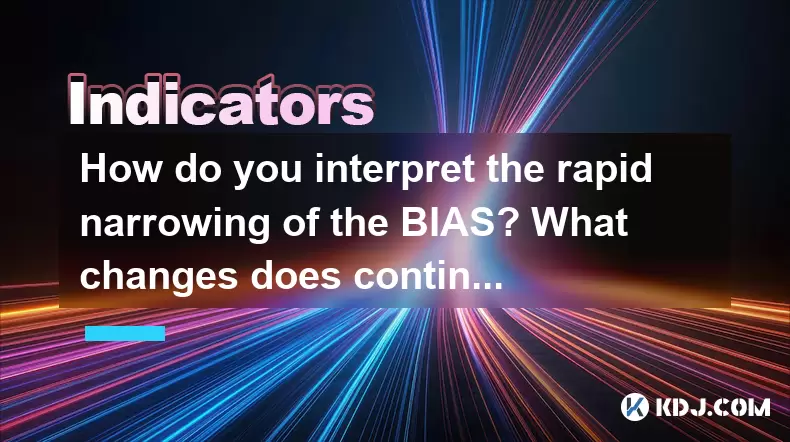
The Bollinger Band Indicator of Absolute Strength (BIAS) is a technical analysis tool used by cryptocurrency traders to gauge the volatility and potential direction of a cryptocurrency's price. The rapid narrowing of the BIAS can be a significant signal to traders, often indicating a potential upcoming breakout or a period of increased volatility. Similarly, continued expansion of the BIAS can suggest different market conditions that traders need to understand to make informed decisions. In this article, we will explore these phenomena in detail and explain what they might mean for cryptocurrency traders.
Understanding the BIAS
The Bollinger Band Indicator of Absolute Strength (BIAS) is calculated using the Bollinger Bands, which are volatility bands placed above and below a moving average. BIAS measures the distance between the upper and lower Bollinger Bands, providing insights into the current volatility of the market. When the BIAS narrows, it indicates that the Bollinger Bands are contracting, suggesting that the market is experiencing low volatility. Conversely, when the BIAS expands, it indicates that the Bollinger Bands are widening, signaling increased volatility.
Interpreting the Rapid Narrowing of the BIAS
The rapid narrowing of the BIAS is often seen as a precursor to a significant price movement. When the Bollinger Bands contract, it suggests that the market is in a state of consolidation. This consolidation period can be followed by a breakout, where the price moves sharply in one direction. Traders often look for this signal to prepare for potential trading opportunities.
- Identify the narrowing BIAS: Monitor the Bollinger Bands on your chosen cryptocurrency chart. Look for the bands to start moving closer together, indicating that the BIAS is narrowing.
- Confirm with other indicators: Use other technical indicators, such as the Relative Strength Index (RSI) or Moving Average Convergence Divergence (MACD), to confirm that a breakout might be imminent.
- Prepare for a breakout: Position yourself for a potential upward or downward movement. This might involve setting up buy or sell orders near the upper or lower Bollinger Bands.
Potential Changes Indicated by Continued Expansion of the BIAS
Continued expansion of the BIAS suggests that the market is experiencing increasing volatility. This can be a double-edged sword for traders. On one hand, increased volatility can lead to significant profit opportunities. On the other hand, it can also result in substantial losses if not managed properly.
- Monitor the expanding BIAS: Keep an eye on the Bollinger Bands as they move further apart, indicating that the BIAS is expanding.
- Assess market conditions: Evaluate whether the increased volatility is due to positive or negative market sentiment. This can be done by analyzing news, social media sentiment, and other market indicators.
- Adjust trading strategies: Depending on your risk tolerance, you might decide to either capitalize on the increased volatility by trading more aggressively or reduce your exposure to minimize potential losses.
Trading Strategies During Rapid Narrowing of the BIAS
Trading during the rapid narrowing of the BIAS requires a strategic approach. Traders can use several strategies to take advantage of the potential breakout.
- Breakout trading: Set up buy orders just above the upper Bollinger Band and sell orders just below the lower Bollinger Band. This strategy aims to capture the price movement as it breaks out of the consolidation phase.
- Straddle strategy: Place both a buy and a sell order around the current price. This strategy can profit from a significant move in either direction.
- Volatility breakout strategy: Use the Average True Range (ATR) to set stop-loss and take-profit levels. This can help manage risk during the breakout.
Trading Strategies During Continued Expansion of the BIAS
Trading during the continued expansion of the BIAS requires a different set of strategies due to the increased volatility.
- Trend following: Use moving averages to identify the overall trend. Trade in the direction of the trend, using the expanding Bollinger Bands to set entry and exit points.
- Range trading: Identify key support and resistance levels within the expanding Bollinger Bands. Buy near the lower band and sell near the upper band, taking advantage of the increased volatility.
- Volatility-based stop-losses: Adjust stop-loss levels based on the expanding BIAS to manage risk more effectively. This can help prevent being stopped out prematurely due to increased volatility.
Risk Management During BIAS Movements
Effective risk management is crucial when trading based on BIAS movements. Whether the BIAS is narrowing or expanding, traders must have a plan in place to protect their capital.
- Set stop-loss orders: Always use stop-loss orders to limit potential losses. Adjust these orders based on the volatility indicated by the BIAS.
- Position sizing: Adjust the size of your positions based on the level of volatility. Smaller positions can help manage risk during periods of high volatility.
- Diversify: Spread your investments across different cryptocurrencies to reduce the impact of volatility on any single asset.
Case Studies of BIAS Movements in Cryptocurrency
Examining real-world examples can provide valuable insights into how BIAS movements affect cryptocurrency prices.
- Bitcoin's BIAS Narrowing: In early 2021, Bitcoin experienced a period of BIAS narrowing, followed by a significant breakout to new all-time highs. Traders who recognized this pattern could have positioned themselves to profit from the subsequent price surge.
- Ethereum's BIAS Expansion: In mid-2020, Ethereum's BIAS began to expand, signaling increased volatility. Traders who adjusted their strategies to account for this volatility could have capitalized on the significant price movements that followed.
Frequently Asked Questions
Q: Can BIAS be used for all cryptocurrencies?
A: Yes, BIAS can be applied to any cryptocurrency that has sufficient trading volume and price data to calculate Bollinger Bands accurately. However, the effectiveness of BIAS may vary depending on the specific market dynamics of each cryptocurrency.
Q: How often should I check the BIAS for my trading strategy?
A: The frequency of checking the BIAS depends on your trading style. Day traders might monitor it closely throughout the day, while swing traders might check it less frequently, such as daily or weekly. The key is to align your monitoring frequency with your trading time frame.
Q: Is the BIAS a standalone indicator, or should it be used with other tools?
A: The BIAS is most effective when used in conjunction with other technical indicators. Combining it with tools like RSI, MACD, and volume indicators can provide a more comprehensive view of market conditions and improve the accuracy of your trading decisions.
Q: How can I automate my trading based on BIAS movements?
A: To automate trading based on BIAS movements, you can use trading bots or algorithmic trading platforms. These tools allow you to program specific entry and exit rules based on the BIAS and other indicators. Ensure that you thoroughly test your automated strategies in a simulated environment before deploying them with real capital.
Disclaimer:info@kdj.com
The information provided is not trading advice. kdj.com does not assume any responsibility for any investments made based on the information provided in this article. Cryptocurrencies are highly volatile and it is highly recommended that you invest with caution after thorough research!
If you believe that the content used on this website infringes your copyright, please contact us immediately (info@kdj.com) and we will delete it promptly.
- Bitcoin Mining Games Are Changing the Crypto Landscape
- 2025-06-15 16:35:12
- Dogecoin & Other Top Memecoins Have Seen A Spike In Social Dominance
- 2025-06-15 16:35:12
- Will XRP Break Above $10? Here's When the Journey May Begin and Should You Buy the Dip?
- 2025-06-15 16:30:12
- The cryptocurrency realm remains volatile, a high-stakes rollercoaster where fortunes turn in the blink of an eye
- 2025-06-15 16:30:12
- Bitcoin Is Approaching an Important Resistance Level on the Daily Charts
- 2025-06-15 16:25:12
- Worldcoin ($WLD) Is Making a Comeback
- 2025-06-15 16:25:12
Related knowledge
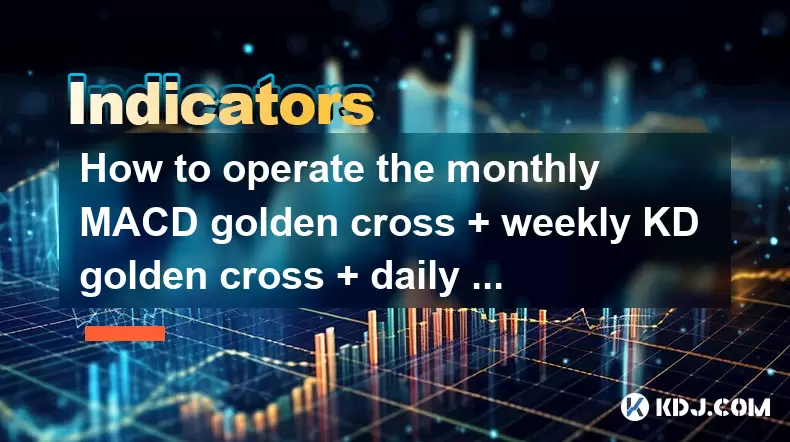
How to operate the monthly MACD golden cross + weekly KD golden cross + daily volume breakthrough?
Jun 15,2025 at 05:36am
Understanding the Strategy: Monthly MACD Golden CrossTo effectively operate the monthly MACD golden cross, traders must first understand what this signal entails. The MACD (Moving Average Convergence Divergence) golden cross occurs when the MACD line crosses above the signal line on a given chart timeframe. When this happens on the monthly chart, it sug...
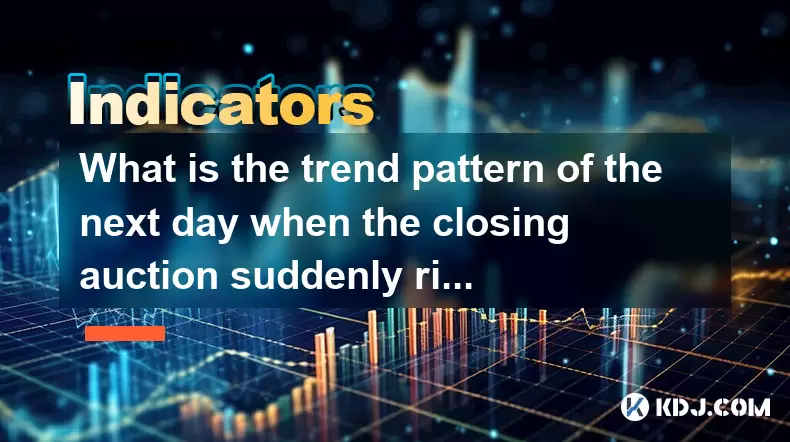
What is the trend pattern of the next day when the closing auction suddenly rises?
Jun 15,2025 at 08:15am
Understanding Closing Auctions in Cryptocurrency MarketsIn the context of cryptocurrency trading, a closing auction refers to a mechanism used by exchanges to determine the closing price of an asset at the end of a trading session. This process typically occurs within a short time window before the market closes for the day and aims to provide a fair an...

What does it mean when the volume fluctuates during the sideways trading at high levels?
Jun 15,2025 at 10:28am
Understanding Volume Fluctuations in Sideways TradingWhen volume fluctuates during sideways trading at high levels, it refers to the changes in the number of assets traded over a given period while the price remains relatively stable, moving within a defined range. This phenomenon typically occurs when the market lacks a clear directional bias—neither b...
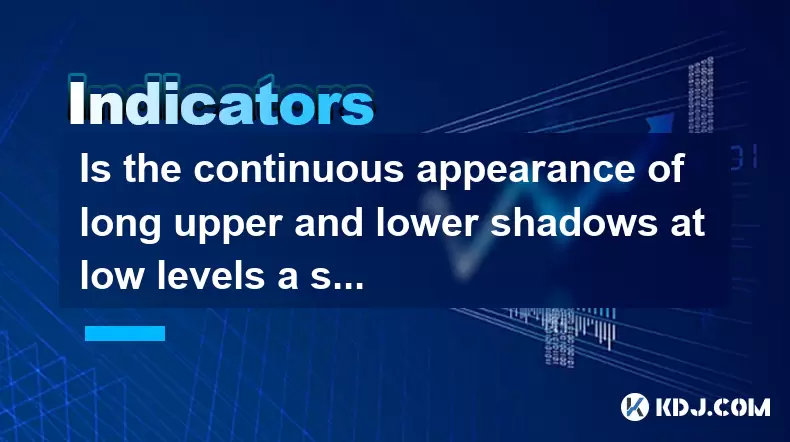
Is the continuous appearance of long upper and lower shadows at low levels a signal of accumulation?
Jun 15,2025 at 01:43am
Understanding Long Upper and Lower Shadows in Candlestick ChartsIn the world of cryptocurrency trading, candlestick patterns are widely used to analyze price movements. A long upper shadow, also known as a wick or tail, indicates that the price rose significantly during the period but was pushed back down by selling pressure. Conversely, a long lower sh...
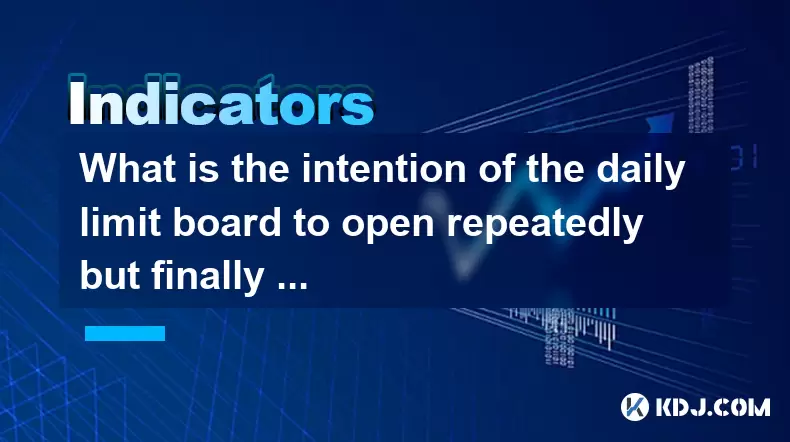
What is the intention of the daily limit board to open repeatedly but finally close?
Jun 15,2025 at 01:08am
Understanding the Daily Limit Board in Cryptocurrency TradingIn cryptocurrency trading, a daily limit board refers to a price movement restriction mechanism applied by certain exchanges or regulatory bodies. This mechanism is primarily used to prevent extreme volatility and panic selling or buying during periods of intense market fluctuation. When an as...

How to calculate the probability of trend continuation after the MACD column divergence?
Jun 14,2025 at 08:01am
Understanding MACD Column DivergenceThe Moving Average Convergence Divergence (MACD) is a widely used technical indicator in cryptocurrency trading. The MACD column, also known as the histogram, represents the difference between the MACD line and the signal line. When price makes a new high or low but the MACD histogram does not confirm this movement, a...

How to operate the monthly MACD golden cross + weekly KD golden cross + daily volume breakthrough?
Jun 15,2025 at 05:36am
Understanding the Strategy: Monthly MACD Golden CrossTo effectively operate the monthly MACD golden cross, traders must first understand what this signal entails. The MACD (Moving Average Convergence Divergence) golden cross occurs when the MACD line crosses above the signal line on a given chart timeframe. When this happens on the monthly chart, it sug...

What is the trend pattern of the next day when the closing auction suddenly rises?
Jun 15,2025 at 08:15am
Understanding Closing Auctions in Cryptocurrency MarketsIn the context of cryptocurrency trading, a closing auction refers to a mechanism used by exchanges to determine the closing price of an asset at the end of a trading session. This process typically occurs within a short time window before the market closes for the day and aims to provide a fair an...

What does it mean when the volume fluctuates during the sideways trading at high levels?
Jun 15,2025 at 10:28am
Understanding Volume Fluctuations in Sideways TradingWhen volume fluctuates during sideways trading at high levels, it refers to the changes in the number of assets traded over a given period while the price remains relatively stable, moving within a defined range. This phenomenon typically occurs when the market lacks a clear directional bias—neither b...

Is the continuous appearance of long upper and lower shadows at low levels a signal of accumulation?
Jun 15,2025 at 01:43am
Understanding Long Upper and Lower Shadows in Candlestick ChartsIn the world of cryptocurrency trading, candlestick patterns are widely used to analyze price movements. A long upper shadow, also known as a wick or tail, indicates that the price rose significantly during the period but was pushed back down by selling pressure. Conversely, a long lower sh...

What is the intention of the daily limit board to open repeatedly but finally close?
Jun 15,2025 at 01:08am
Understanding the Daily Limit Board in Cryptocurrency TradingIn cryptocurrency trading, a daily limit board refers to a price movement restriction mechanism applied by certain exchanges or regulatory bodies. This mechanism is primarily used to prevent extreme volatility and panic selling or buying during periods of intense market fluctuation. When an as...

How to calculate the probability of trend continuation after the MACD column divergence?
Jun 14,2025 at 08:01am
Understanding MACD Column DivergenceThe Moving Average Convergence Divergence (MACD) is a widely used technical indicator in cryptocurrency trading. The MACD column, also known as the histogram, represents the difference between the MACD line and the signal line. When price makes a new high or low but the MACD histogram does not confirm this movement, a...
See all articles

























































































